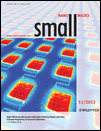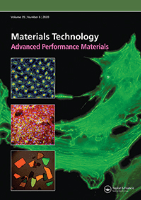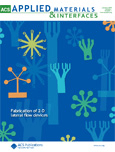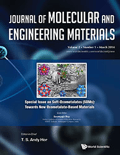
Digest Journal of Nanomaterials and Biostructures
Scope & Guideline
Exploring the Frontiers of Nanotechnology and Biostructures
Introduction
Aims and Scopes
- Nanomaterials Synthesis and Characterization:
The journal publishes articles on various synthesis methods for nanomaterials, including chemical, physical, and biological approaches. Characterization techniques such as spectroscopy, microscopy, and thermal analysis are emphasized to understand the properties of these materials. - Applications of Nanomaterials:
Research on the practical applications of nanomaterials in areas such as catalysis, electronics, energy conversion and storage, environmental remediation, and biomedical fields is a key focus of the journal. - Biostructures and Biomaterials:
The journal explores the development and application of biostructures and biomaterials, addressing their interactions with biological systems, biocompatibility, and potential in medical and pharmaceutical applications. - Theoretical and Computational Studies:
In addition to experimental studies, the journal encourages submissions that involve theoretical modeling and computational simulations to predict the behavior and properties of nanomaterials. - Interdisciplinary Approaches:
The journal promotes interdisciplinary research that combines nanotechnology with other fields such as physics, chemistry, materials science, and biology, fostering innovative solutions to complex problems.
Trending and Emerging
- Green Synthesis of Nanomaterials:
There is a growing trend towards environmentally friendly synthesis methods for nanomaterials, utilizing biological templates and renewable resources, which aligns with global sustainability goals. - Nanocomposites for Energy Applications:
Research on nanocomposites for energy storage and conversion, including batteries and supercapacitors, has surged, reflecting the demand for efficient energy solutions. - Biomedical Applications of Nanomaterials:
The application of nanomaterials in drug delivery, cancer therapy, and tissue engineering is increasingly prominent, highlighting the potential of nanotechnology in advancing healthcare. - Photocatalytic and Environmental Remediation Technologies:
Studies focusing on photocatalytic materials for environmental remediation and pollutant degradation are on the rise, driven by the need for effective solutions to environmental challenges. - Smart and Responsive Materials:
The development of smart materials that respond to environmental stimuli (e.g., pH, temperature, light) is gaining traction, showcasing the innovative potential of nanostructured materials in various applications.
Declining or Waning
- Traditional Bulk Materials:
Research on traditional bulk materials has been declining as the focus shifts towards nanostructured materials, which offer superior properties and functionalities. - Basic Theoretical Studies:
There has been a noticeable decrease in basic theoretical studies that do not directly link to practical applications, as the journal increasingly prioritizes research with clear applications in nanotechnology and biostructures. - Legacy Biomaterials:
The exploration of older biomaterials that do not incorporate nanotechnology has waned, as newer, more effective nanostructured biomaterials are being developed and researched. - Conventional Characterization Techniques:
Submissions focusing solely on conventional characterization techniques without integrating advanced methods or novel applications are becoming less frequent, as researchers seek to provide more comprehensive analyses. - Limited Environmental Applications:
Research specifically targeting environmental applications of nanomaterials has seen a reduction, potentially due to a shift towards more specialized studies in energy and biomedical applications.
Similar Journals

Nano Express
Bridging theory and application in materials science.Nano Express is an esteemed open-access journal published by IOP Publishing Ltd, dedicated to advancing research in the fields of nanotechnology and materials science. Since its launch in 2020, the journal has swiftly established itself as a vital resource for researchers and professionals, garnering significant recognition in various domains, including biomaterials, electronic, optical and magnetic materials, and polymers and plastics. With a commendable categorization in Scopus quartiles, it ranks in Q2 for Electronic, Optical and Magnetic Materials, and maintains a top percentile in several others, exemplifying its commitment to high-quality research dissemination. Located in the United Kingdom, this journal fosters a global dialogue among experts and newcomers alike, facilitating open access to innovative research that drives the future of nanotechnology. By offering a platform for groundbreaking studies and reviews, Nano Express aims to bridge the gap between theoretical understanding and practical application, championing the development of next-generation materials that have the potential to transform various industries.

Nanoscience and Technology-An International Journal
Innovating Tomorrow's Materials TodayNanoscience and Technology-An International Journal, published by BEGELL HOUSE INC, is a leading platform dedicated to the rapidly evolving fields of nanoscience and nanotechnology. With its ISSN 2572-4258 and E-ISSN 2572-4266, the journal serves as a crucial resource for researchers, professionals, and students alike, focusing on advanced materials, condensed matter physics, and mechanics of materials. It holds a commendable position in the scholarly community, evidenced by its Q2 ranking in 2023 across multiple categories including Condensed Matter Physics and Materials Science. The journal aims to disseminate high-quality research, promote interdisciplinary collaboration, and facilitate innovation within the nano realm. With its convergence period from 2019 to 2024, it continues to attract a diverse array of studies and insightful contributions, reinforcing its importance in shaping the future of nanotechnology and its applications.

BULLETIN OF MATERIALS SCIENCE
Advancing the Frontiers of Materials ScienceBulletin of Materials Science, published by the Indian Academy of Sciences, is a distinguished journal that has been contributing to the field of materials science since its inception in 1979. With an ISSN of 0250-4707 and E-ISSN 0973-7669, it provides a platform for researchers to share groundbreaking studies and advancements in the mechanics of materials and general materials science. As of 2023, the journal holds a respectable Q3 ranking in both the Materials Science (miscellaneous) and Mechanics of Materials categories, highlighting its competitive position in the academic landscape. Although the journal currently does not operate under an open access model, it remains a vital resource for professionals and students keen on exploring innovative material developments and methodologies. With a commitment to promoting high-quality research, the Bulletin of Materials Science features rigorous peer-review processes, making it an essential reference for anyone engaged in the materials science domain.

Small
Transforming Ideas into Applications Through Small Science.Small is a premier academic journal published by WILEY-V C H Verlag GmbH, focusing on cutting-edge research across a multitude of disciplines including biomaterials, biotechnology, chemistry, engineering, materials science, medicine, and nanoscience. With an impressive impact factor and recognized in the top quartile (Q1) across these categories, Small serves as a vital platform for scientists and researchers aiming to disseminate innovative findings and explore the interplay between small-scale materials and their large-scale applications. Enjoying a broad readership, the journal has been key in advancing knowledge from its inception in 2005 and aims to foster collaborations and discussions that steer the future of material science and biotechnology. Though not open access, research published in Small remains invaluable for professionals and students eager to explore the advancements at the nanoscale, promoting a comprehensive understanding of modern scientific challenges and opportunities.

MATERIALS TECHNOLOGY
Unlocking the Potential of Condensed Matter PhysicsMATERIALS TECHNOLOGY is a prestigious academic journal published by Taylor & Francis Ltd, based in the United Kingdom. With an ISSN of 1066-7857 and an E-ISSN of 1753-5557, this journal has established itself as a vital resource in the fields of Condensed Matter Physics, Materials Science, Mechanical Engineering, and Mechanics of Materials, earning a Q2 ranking in multiple categories as of 2023. With a rich publication history that dates back to the early 1970s, it serves as an essential platform for disseminating innovative research and developments in materials technology. Although not available through Open Access, the journal continues to attract contributions from leading researchers, ensuring high-quality articles that advance knowledge in the materials domain. The journal's commitment to excellence is reflected in its notable Scopus rankings, placing it within the 70th to 78th percentiles across several engineering and physics categories. As a vital resource for researchers, professionals, and students alike, MATERIALS TECHNOLOGY plays a critical role in shaping the future of materials science and engineering.

Frontiers of Materials Science
Fostering Collaboration for Tomorrow's Material SolutionsFrontiers of Materials Science is a groundbreaking journal dedicated to exploring advanced materials and their applications within the ever-evolving landscape of materials science. Published by HIGHER EDUCATION PRESS, this journal offers a crucial platform for scholars and practitioners seeking to disseminate innovative research findings that foster interdisciplinary collaboration. Since its inception in 2011, the journal has enjoyed a notable Q2 ranking in the category of Materials Science (miscellaneous) as of 2023, positioning it among the noteworthy publications in the field with a Scopus rank of #222 out of 463. While predominantly published in China, the journal is committed to open access principles, allowing global accessibility to cutting-edge research. With its comprehensive coverage spanning materials synthesis, characterization, properties, and applications, Frontiers of Materials Science not only serves as a repository for academia but also bridges the gap between research and industry, making it an indispensable resource for researchers, professionals, and students alike.

ChemNanoMat
Pioneering Discoveries in Biomaterials and EnergyChemNanoMat is a prestigious academic journal published by WILEY-V C H VERLAG GMBH, dedicated to the rapidly evolving fields of nanoscale materials and their applications in diverse areas such as biomaterials, energy engineering, and environmental sustainability. With the journal's ISSN 2199-692X and recognized quality, as evidenced by its Q2 rankings across multiple categories—including Biomaterials and Renewable Energy—ChemNanoMat serves as a crucial platform for researchers, professionals, and students to disseminate their findings and foster collaborations. Operating from Germany, the journal encourages the exploration of innovative materials solutions to meet tomorrow's challenges. While it does not currently offer open access options, it remains highly regarded in the academic community with a competitive impact factor that emphasizes its relevance and influence in guiding future research directions. Covering a broad scope from 2015 through 2024, ChemNanoMat is key for anyone invested in the advancement of materials chemistry and related scientific fields.

ACS Applied Materials & Interfaces
Unleashing the Potential of Interdisciplinary ResearchACS Applied Materials & Interfaces, published by the American Chemical Society, stands as a leading journal in the field of applied materials, nanotechnology, and interdisciplinary research in medicine. With an impressive Impact Factor that places it in the Q1 category across Materials Science, Medicine, and Nanoscience and Nanotechnology, this journal consistently ranks among the top tier, evidencing its significance and influence in advancing scientific knowledge. The journal’s scopus ranking of 33 out of 463 in General Materials Science further underscores its critical role in disseminating innovative and high-quality research. Although it is not an open-access journal, a diverse range of access options is available, ensuring that vital research findings are accessible to a broad audience of researchers, professionals, and students. Targeting breakthroughs in the synthesis, characterization, and application of materials and interfaces, ACS Applied Materials & Interfaces serves as a pivotal platform for publishing cutting-edge studies essential for future technological advancements.

Journal of Molecular and Engineering Materials
Exploring the Nexus of Molecular Science and EngineeringThe Journal of Molecular and Engineering Materials, published by World Scientific Publishing Co Pte Ltd, is a leading peer-reviewed journal that focuses on the intricate relationship between molecular science and engineering practices. With the ISSN 2251-2373 and E-ISSN 2251-2381, this journal aims to foster the exchange of cutting-edge research and developments within the fields of materials science, molecular engineering, and related applications. Although the journal currently does not operate under an Open Access model, it remains a vital resource for researchers, professionals, and students seeking in-depth knowledge and innovative methodologies in material design and engineering. The journal's esteemed reputation is reflected in its commitment to publishing high-quality research that addresses contemporary challenges and opportunities in material science, thereby contributing to advancements in technology and industry.

FULLERENES NANOTUBES AND CARBON NANOSTRUCTURES
Connecting Researchers to the Cutting Edge of Carbon ScienceFULLERENES NANOTUBES AND CARBON NANOSTRUCTURES, published by Taylor & Francis Inc, stands at the forefront of research in the fields of nanotechnology, materials science, and organic chemistry. With an ISSN of 1536-383X and an E-ISSN of 1536-4046, this journal offers a critical platform for disseminating significant findings related to carbon-based nanostructures, materials characterization, and their innovative applications. Recognized for its scholarly impact, the journal enjoys a Q2 ranking in several fields, including Atomic and Molecular Physics, Materials Science, and Organic Chemistry, reflecting its commitment to quality research. Since its inception in 2002, it has maintained a rigorous publication standard and provides open access options, enabling a diverse audience, from researchers to industry professionals, to engage with the latest advancements. The journal's comprehensive scope across converged years until 2024 emphasizes its pivotal role in fostering knowledge in the rapidly evolving realm of nanoscience and nanotechnology. Researchers and practitioners alike are encouraged to explore the cutting-edge research showcased in this vital resource.